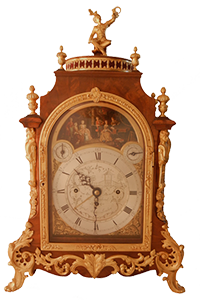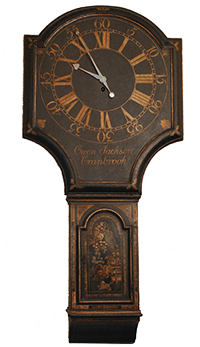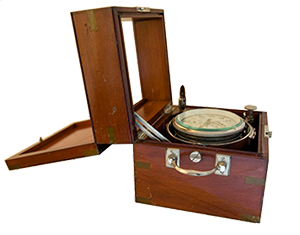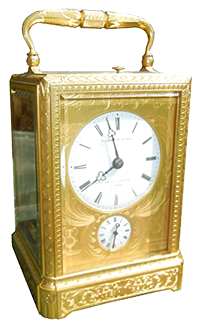This page explains the difference between different types of clocks.
If you have ever wondered, “What is a Regulator?” or “What is a chronometer?” or other type of clock, you will find your answer here.
 Longcase, Tallcase, Grandfather clock
Longcase, Tallcase, Grandfather clock
All of these clocks are Longcase Clocks. In America, “tallcase” is frequently used. Longcase Clocks were called Grandfather clocks after 1876 when Henry Clay Work composed the popular song “My Grandfather’s Clock”.
The Longcase Clock form started in the 1600’s in Europe. Originally starting as a wall clock, the trunk soon developed to hide the weights traveling down the wall. Early examples were much smaller and narrower. As the movements became sophisticated and heavier, they needed to be supported by the case, not just the dial. In addition, as the pendulum developed from a foliot, to a short pendulum, then to the seconds pendulum, the width and length of the case increased to accommodate the longer pendulum and wider arc of swing. Continued study and development by English horologists resulted in a dependable and highly accurate clock mechanism and form. Some of these horologists included, but are not limited to: the Fromenteel family, George Graham, John Harrison, Henry Jones, Thomas Tompion, Justin Vulliame, Daniel Quare and Joseph Knibb. To own one of their clocks is to own the work of a scientist, engineer and artist. Their clocks are a moment in the history of the science of timekeeping. These men and others worked in the large and royal cities, close to their financial supporters and close to the fine cabinetmakers of their day. Fine quality timepieces came from the cities and had an elegance of design, proportion, size, line, and detail that the country clockmakers would copy.

The Longcase Clock is capable of many functions. It may be musical and or chime at the quarter hours. There may be a moon phase crossing in the arch of the dial, showing the age of the moon. Delightfully, there may be a rocking ship, Eve offering Adam an apple or children on a seesaw. Subsidiary dials or apertures within the chapter ring may show the seconds, day and date. It may even show the high tide and choice of tune. The fine quality clock typically has a brass dial with silvered chapter rings, subsidiary rings and gold lacquered spandrel corners, or an engraved silvered dial. Country clocks generally have a painted dial, possibly white with decorative motifs in the spandrel corners such as flowers, the four seasons, or the continents. They, too, could have an engraved silvered brass dial
The longcase clock is a heritage piece to own and pass to generations to come.
Regulator
Not to be confused with longcase clocks, the regulator is more often a standing floor clock. This clock is a scientific instrument of time and noted for its accuracy. All the details of its construction were to improve the accuracy of the movement. To understand a clock movement is to understand the control of energy as it is released from the spring or weight. Regulators have many of the following characteristics:
Striking:
The regulator is rarely a striking clock. The purpose of the regulator is the accurate measurement of time, not announcing the time. The energy required to power the gear train for the strike and the subsequent vibration caused by the striking of the bell by the hammer would interfere with the accuracy of the power train for time keeping.
Maintaining Power:
When a clock is wound, the train of gears reverses; the gears are moving backward instead of forward. In order to compensate for this, the regulator will have “maintaining power.” This is the ability to maintain the hand’s forward movement and escapement while the clock is wound.
 Dead Beat Escapement:
Dead Beat Escapement:
An escapement releases the train of wheels in a regulated time and speed. A dead beat escapement: reduces the amount of power needed, it reduces the swing of the pendulum and helps to eliminate circular error by forcing the pendulum to closely follow a parabolic arc, and it also eliminates recoil of the seconds hand, a superfluous movement that would waste energy and interfere with the accuracy of time keeping.
Compensating Pendulum:
If the length of a pendulum should vary due to changes in temperature, it would interfere with the time keeping of the clock. To compensate for this, the rod and bob are composed of various metals. Each metal has its own temperature sensitivity that expands or contracts in relation to the temperature of the room to maintain the length of the pendulum.
Dial:
The dial of a regulator shows its scientific intent, breaking down time into each of its elements. The outer ring is the chapter ring and shows sweep minutes. Subsidiary dials within the chapter ring show seconds and hours.
The floor regulator has an equally elegant case as the longcase clock, but can be slightly smaller. It is traditionally found in a scientific institution, observatory or clock shop to regulate other timepieces. Domestically, it is placed in the library or study. A handsome clock with a serious intent of purpose, the regulator would be at home with anyone interested in the history of accurate time keeping.
Bracket
 The Bracket Clock is a smaller clock, usually up to 20 inches tall. It was originally made to sit on a table, but got its name when the clock was later made with a bracket to place upon the wall. Bracket Clocks have glass on all four sides of the cases to enjoy the beautiful movements and ornate engraving on the plates. To allow the user to view the clock in its entirety, they would be placed on a freestanding table or pedestal so one could walk around them. Additionally they may be placed on a side-table against the wall on which a mirror is hung, allowing the back of the clock to be viewed. The movement is frequently striking and may even be a repeater strike. In a time when candles provided light and reading glasses were not yet invented, it was important to have another chance to hear the time. So, with a simple pull on a string, you could hear the time within a 15-minute range. Ideal for the smaller home and in character with a grander scale, the Bracket Clock is a highly adaptable form.
The Bracket Clock is a smaller clock, usually up to 20 inches tall. It was originally made to sit on a table, but got its name when the clock was later made with a bracket to place upon the wall. Bracket Clocks have glass on all four sides of the cases to enjoy the beautiful movements and ornate engraving on the plates. To allow the user to view the clock in its entirety, they would be placed on a freestanding table or pedestal so one could walk around them. Additionally they may be placed on a side-table against the wall on which a mirror is hung, allowing the back of the clock to be viewed. The movement is frequently striking and may even be a repeater strike. In a time when candles provided light and reading glasses were not yet invented, it was important to have another chance to hear the time. So, with a simple pull on a string, you could hear the time within a 15-minute range. Ideal for the smaller home and in character with a grander scale, the Bracket Clock is a highly adaptable form.
Tavern or Act of Parliament
 In the middle of the 18th century, travel by coach required that inns and accompanying taverns have accurate clocks for the regulation of the coach schedule. Unfortunately, in 1797, an Act of Parliament set a duty of 5 shillings for any person owning a clock. While nearly ruining the clock making business, it made the public clock very important to the community. Since these Tavern Clocks remained out of necessity, they became known as “Act of Parliament Clocks”.
In the middle of the 18th century, travel by coach required that inns and accompanying taverns have accurate clocks for the regulation of the coach schedule. Unfortunately, in 1797, an Act of Parliament set a duty of 5 shillings for any person owning a clock. While nearly ruining the clock making business, it made the public clock very important to the community. Since these Tavern Clocks remained out of necessity, they became known as “Act of Parliament Clocks”.
To say the Act of Parliament is a painted wall clock is to do it a great injustice. The dial is approximately three feet across and shaped like a shield or round with a drop case for the seconds pendulum. Painted black, green or even red, the numbers and makers name were elegantly painted in gilt. Occasionally, they had a white dial with the numbers and makers name in black. There was no such thing as missing the time with a clock like this in the tavern. Today, this clock is an ideal choice for an accent item to make a focal point or graphic statement in a room.
Marine Chronometer
 The word “chronometer” has had several meanings over time. It is derived from the Greek word chronos, meaning a space of time or measurement, and the Greek word metron, meaning a measure. Some will note that fine quality modern watches use the term chronometer. This dates back to 1951 in Switzerland when the Swiss Federation of Watch Manufacturers ruled that chronometer meant a precision watch that was regulated in different positions and temperatures and then awarded an official timing certificate. However, the chronometer as we will use it here, refers to a clock mechanism that uses a detent escapement (as opposed to a lever escapement) and a free spring balance. It is also known as a Marine Timekeeper.
The word “chronometer” has had several meanings over time. It is derived from the Greek word chronos, meaning a space of time or measurement, and the Greek word metron, meaning a measure. Some will note that fine quality modern watches use the term chronometer. This dates back to 1951 in Switzerland when the Swiss Federation of Watch Manufacturers ruled that chronometer meant a precision watch that was regulated in different positions and temperatures and then awarded an official timing certificate. However, the chronometer as we will use it here, refers to a clock mechanism that uses a detent escapement (as opposed to a lever escapement) and a free spring balance. It is also known as a Marine Timekeeper.
Many people are familiar with the story behind the search for longitude and the work of John Harrison (1693-1776) to create a time keeping mechanism that would endure the roll of the seas, humidity, atmospheric changes, cold and heat and keep as close a time as possible with Greenwich Mean Time. After decades of work and 5 timepieces, he received the award of 20,000 pounds sterling by the Board of Longitude in 1763. However, the work and improvement by Thomas Earnshaw (1749-1829) on the detached escapement created the marine chronometer that is collectable now. It was in use by the navies and trade ships of the 18th and 19th centuries.
These handsome timepieces were hung in a gimbal and then housed in a mahogany box case that had two lids. The top lid opened to view the time through a glass window, thereby protecting the movement from the elements. The second lid allowed access to the movement for winding. The Marine Chronometer is an approximate 7-inch cube. It is as suitable in an office or home as it is aboard any ship.
Carriage
 The Carriage Clock is a portable timepiece that is balance controlled and has a platform escapement. The balance and hairspring release the train in equal parts to regulate the speed at which the train of gears run. By placing the escapement and balance spring on a platform on top of the movement, the friction on the pivot was reduced to just the tip or end of the pivot, as opposed to if the balance spring was in a vertical plane, it’s pivot would experience greater friction on it’s side (so to speak). This reduction in friction created a more accurate release of power. In addition the balance was necessary for the portable movement. A pendulum would hardly work in a portable clock movement.
The Carriage Clock is a portable timepiece that is balance controlled and has a platform escapement. The balance and hairspring release the train in equal parts to regulate the speed at which the train of gears run. By placing the escapement and balance spring on a platform on top of the movement, the friction on the pivot was reduced to just the tip or end of the pivot, as opposed to if the balance spring was in a vertical plane, it’s pivot would experience greater friction on it’s side (so to speak). This reduction in friction created a more accurate release of power. In addition the balance was necessary for the portable movement. A pendulum would hardly work in a portable clock movement.
The balance-controlled movement was not used much until the later part of the 17th century. After which, the travelling clock took many forms: the German Drum shaped table clock, the European “Tabernacle” Clock, the French and English Coach Watch, the Miniature English Traveling Clock (which is really a small version of the Bracket Clock with a controlled balance escapement), the French Pendule D’Officier, the English Sedan Clock and the French Portable Hanging Clock. By the early 1800’s, the French carriage clock form recognized today was developed by the great French horologist Abraham-Louis Breguet.
Other important French names include, Garnier, Drocourt, Bourdin, Leroy and Jacot. The work of Paul Garnier in creating a movement capable of mass production allowed many French carriage clocks to be exported and sold at reasonable prices. Many of them went to England.
The English Carriage Clock trade was smaller and produced movements and cases of finer quality then the production run French Carriage Clock. This is not to say the French clocks were poorly or cheaply made in the modern sense of the word. The difference was in the finishing and the execution. Famous English maker names include: Cole, Vulliamy, Arnold, Frodsham and Dent. Both the French and English makers had additional craftsmen helping with the completion of a clock; workmen were known for their specialty talents from making pivots, lever platforms, finishers, and barrel makers.
Carriage Clocks came in many forms, but there is a recognizable uniformity in the size and proportions and the constant appearance of the handle. They could be a rectangular case of wood, such as rosewood or mahogany or they could be gilded brass or silver. The “one piece” design consists of mitered uprights and cross pieces with glass panels. This progressed into a “multi-piece” form with four-corner uprights and a decorative base and cap. And again, all styles had the all-important handle, which creates its portability. This form developed into classic designs named by the French like the obis, gorge and corniche. The sides and top panels may be beveled glass, cloisonné, Limoges or guilloche enamel, porcelain, marble or engraved or machined plates. A few examples of later styles that reflected the fancy design vogue of the times were: classic Roman architectural styling with pediment and columns or caryatids, art nouveau, art deco, heavily-sculptural rococo and Chinese styling with pagoda forms or a bamboo look. Rare examples of oval shaped carriage clocks were made as well.
There are three standard size categories for Carriage Clocks. The miniature, called mignonettes or “little darlings” by the French, ranged in size from 3 ¾ inches to 5 inches with the handle up. The “full-size” was 5 ½ to 7 inches tall. Finally, the “Giant” was 9 inches tall with the handle up.
The carriage clock movement was capable of many operations, including telling the date, indicating the phase of the moon, sounding an alarm, and repeating the time on bells by pulling a chain or pressing a button (known as a “repeater”). Common forms are known as time only (no striking), time and strike (the hour, then a single bell at the half hour), petite sonnerie (full hours on the hour, quarters on passing, and a choice of silent), grand sonnerie (the hour and quarters struck on each quarter on passing or like a petite sonnerie, hours on passing and quarters on passing, or silent). Both the petite and grand sonnerie have a lever on the bottom of the case giving a choice of striking options.
Carriage clocks came in so many styles it is impossible to sum all of them up here. However, the words elegant, beautiful and even sweet are certainly appropriate. The carriage clock is at home on a side table, dresser or make-up table in a bedroom, or on an end table or coffee table in a living room, and would be a worthy addition to the tasteful home.
